- Dec 01, 2020
- Lauren Hassani
A Home for the Ages
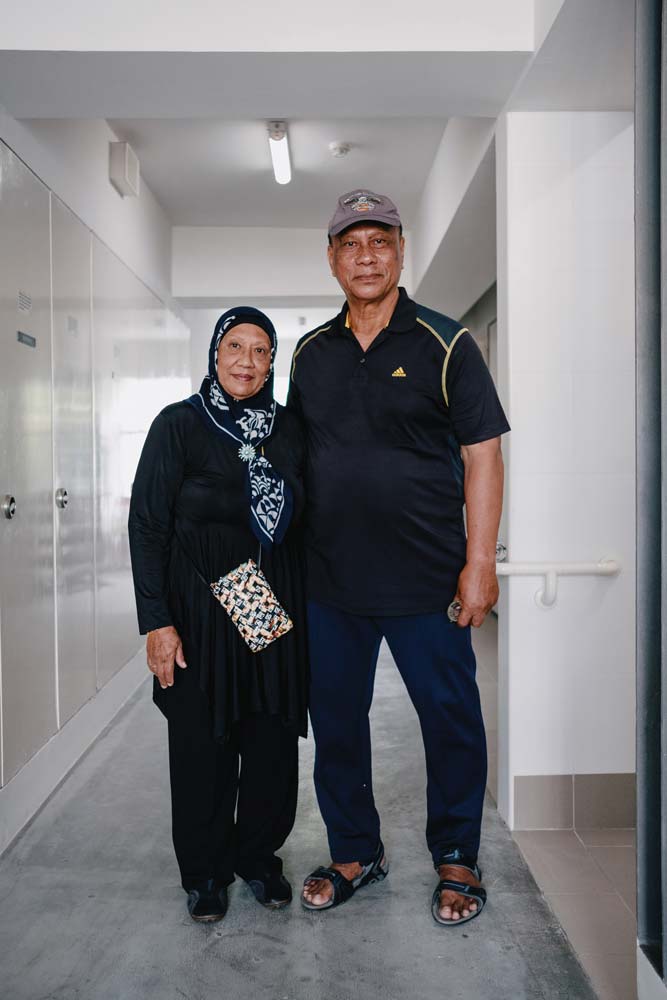
An innovative public housing complex in Singapore represents the island-nation’s approach to population aging.
Even though Sarip Junit, 73, and his wife Asnah Daud, 70, downsized to a compact, 36-square-meter (387-square-foot) apartment, they have never been happier. A shortage of personal living space hasn’t constrained their retirement plans. In fact, their home has given them a more expansive view of retired life, as well as that element essential to aging well: independence.
The recently retired couple (he was a policeman, she worked in the finance department of a hotel) are the lucky owners of one of 104 units in Kampung Admiralty, Singapore’s most innovative public housing development. The remarkable building, located in a northern enclave, integrates under one roof a mix of social, healthcare, communal, commercial, and housing facilities tailored for those age 55 and over. It has become a resounding success story in the city-state’s latest efforts to address population aging, serving as a test lab for innovative ideas and practices.
Singapore-based architecture firm WOHA embraced the challenge, devising an ingenious “club sandwich” design that won 2018’s Building of the Year Award at the World Architecture Festival in Amsterdam. And indeed, the building, with its two 11-story towers and terraced rooftop gardens does resemble a chunky architectural sandwich,
striated into layers serving different functions: community areas and retail on the bottom, medical center in the middle floors, and the top portion containing residential spaces for seniors and outdoor parks.
On a typical day, Junit and Daud can be found in many of these so-called “layers” — meeting up with friends downstairs in the 900-seat hawker center or in the open-air plaza participating in free exercise classes (Junit is partial to Zumba), and volunteering at the Active Ageing Hub, a senior center located on the sixth floor (Daud likes to teach crafting classes here).
According to Junit, living at Kampung Admiralty is truly like living in a kampung, the Malay word for “village.” “The difference is only in the style of housing,” he says. His apartment, outfitted with modern conveniences and features specifically designed for older residents, is a far cry from the wooden huts found in the traditional villages of his youth — but the “kampung spirit” is in full effect.
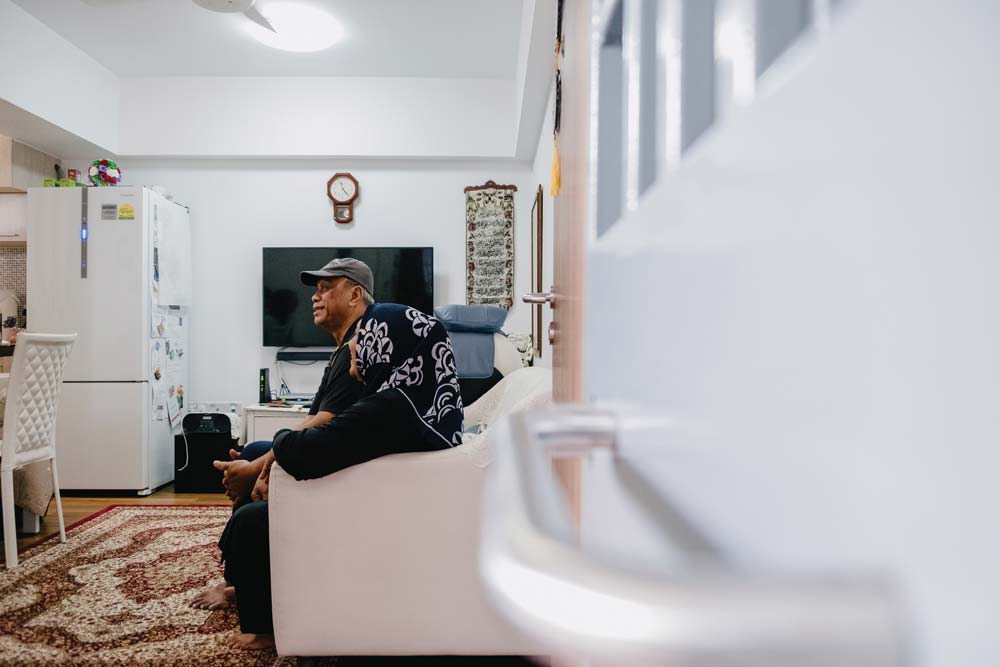
Sarip Junit, 73, and his wife Asnah Daud, 70, downsized to a compact, 36-square-meter (387-square-foot) apartment, they have never been happier.
For Singaporeans, this phrase is synonymous with social cohesion, camaraderie, and understanding — in other words, a sort of neighborly co-dependence that many older citizens cite as a casualty of modern society. The phrase, used increasingly in government and corporate campaigns alike, is meant to evoke with a rose-tinted nostalgia the Singapore of the 1950s and ‘60s, when citizens lived in close proximity within kampungs, bound by shared experience and a willingness to help each other.
Kampung Admiralty, completed in 2018, was conceived as a modern-day realization of this kampung spirit, a vertical village that brings its residents together in myriad ways and offers them a richer, more fulfilling life in their later years. It was inspired in part by the growing needs of the Baby Boomer cohort, born post-WWII and roughly one million strong (30 percent of the population), who began turning 65 in 2012.
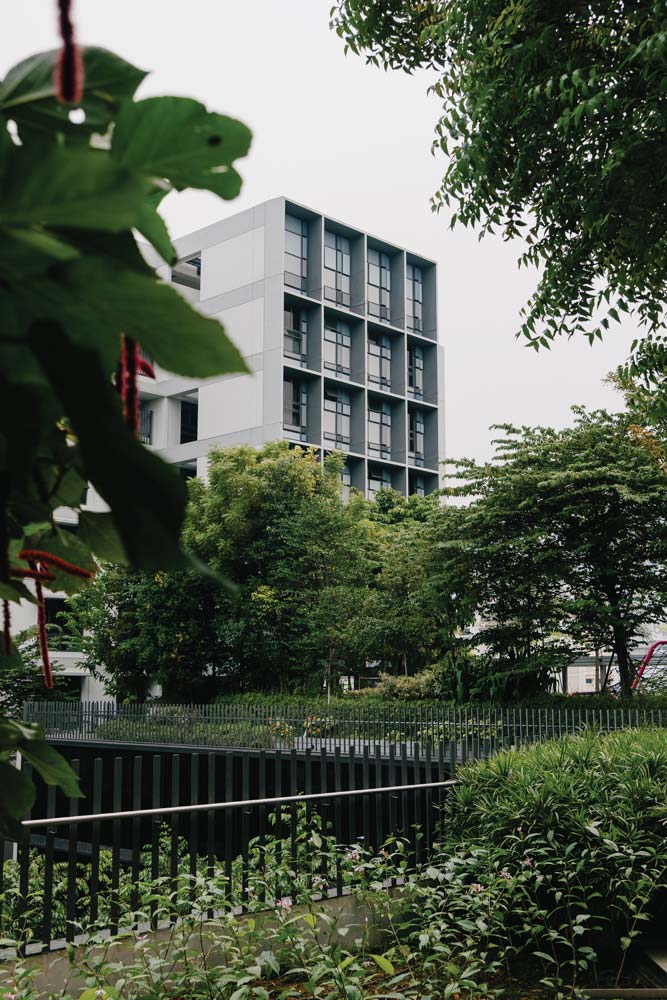
Like many countries, Singapore is grappling with the ramifications of a burgeoning senior population. One of the highest life expectancies in the world, combined with one of the lowest birth rates, has precipitated rapid demographic change, making it an official aged society (defined by the World Health Organization as a society in which more than 14 percent of the population is 65 years or older) as of 2019. By 2030, one in four Singaporeans will be age 65-plus, and by 2050, it’s estimated that nearly half the country will fall into that age bracket — a daunting prospect for even the most well-prepared government.
Luckily, Singapore is more ready than most, applying the same oversight and thorough planning processes to population aging as it does to other aspects of governance. As early as the 1980s, nearly two decades before it would be officially classified as an aging society, Singapore was already looking ahead to the impending shift and examining potential long-term solutions. During the mid-2000s, as the needs of seniors became more sharply pronounced, family structures evolved, and life expectancies increased, the Ministry of Health formed a Ministerial Committee on Ageing to address these issues.
In 2015, the government enacted its most ambitious plan yet, launching the S$3 billion Action Plan for Successful Ageing, which covers 60 initiatives in 12 areas from healthcare and employment, to public spaces and transport. The hallmark of the Plan involves bringing together all sectors and agencies to enact their ambitious programs, with the goal of creating a holistic age-friendly urban environment — a strategy tied to Singapore’s distinctive geographic constraints and high population density.
In the case of Kampung Admiralty, the development process brought together a slew of government agencies. The project was spearheaded by the Housing and Development Board (HDB) and joined by the Ministry of Health (MOH), National Environment Agency (NEA), National Parks Board (NParks), and Land Transport Authority (LTA), to name just a few — in addition to private businesses and design firms. “The biggest challenge,” explains Yap Chin Beng, a senior advisor at HDB, “was to get all the stakeholders to compromise their respective preferences and priorities to work together towards a common vision.”
The project had all the makings of a bureaucratic battle of epic proportions — yet the building was completed with remarkably few headaches, a testament to the efficacy of a “whole-of-government approach” that Singapore has employed since its founding.
The building was completed with remarkably few headaches, a testament to the efficacy of a “whole-of-government approach” that Singapore has employed since its founding.
To better understand Singapore’s aging landscape — and how Kampung Admiralty fits into this scene — it helps to first understand the origins of the tiny island city-state, population 5.7 million, located just off the southern tip of the Malaysian peninsula in Southeast Asia. Throughout its history, Singapore served as an important port city, due to its strategic location along major East-West maritime trade routes. The arrival in 1819 of Sir Stamford Raffles of the British East India Company marked the beginning of 144 years of British colonial rule, during which the city grew and prospered. It wasn’t until 1963 that Singapore once again became a Malaysian state, and 1965 when the city officially left the Federation of Malaysia to become the Independent Republic of Singapore.
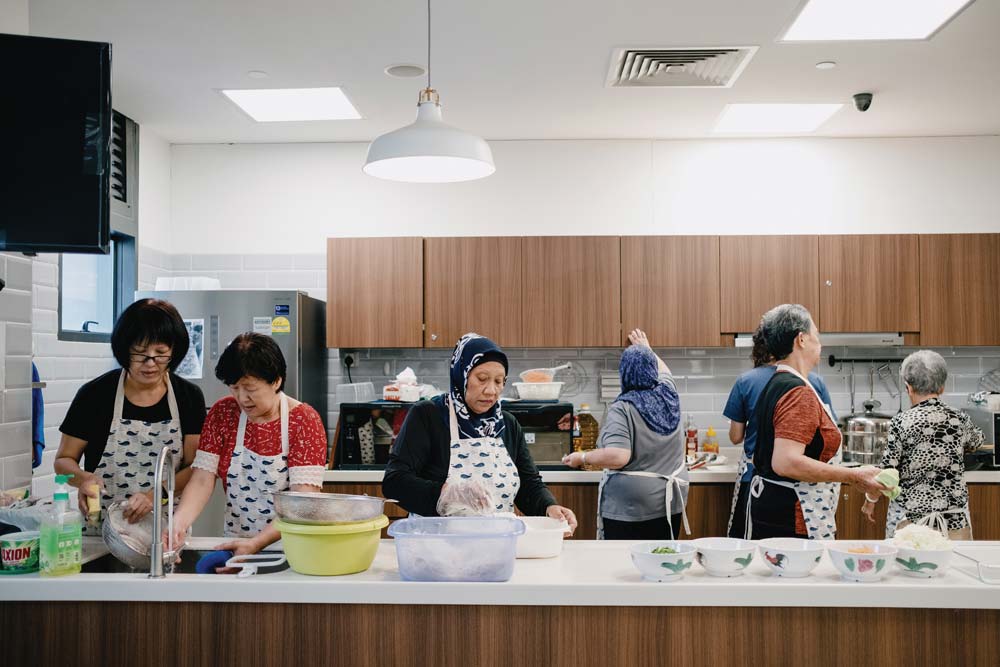
Members of the Active Ageing Hub's cooking club meet every Wednesday in the center's kitchen. The fee to try their home cooking is S$2 per person, which covers the cost of ingredients.
The modern state of Singapore is quite young — just five-and-a-half decades old. Its head-spinning ascent from underdeveloped country rife with poor living conditions, low literacy rates, and unemployment, to a global financial powerhouse within the span of just a generation is one of the 20th century’s greatest case studies in development.
For 30 years, Singapore’s founding father, Lee Kuan Yew, maintained tight control over all aspects of his fledgling country, from industry and urban planning down to the smallest aspects of citizens’ lives (his government was notorious for banning chewing gum). No detail was too small; Lee himself even picked out a specific green vine for beautifying bridges, overpasses, and concrete buildings. In 1965, as Singapore grappled with dire economic straits after newly separating from Malaysia, the government stepped in, actively commandeering the country’s growth across socioeconomic sectors to ensure its success.
State oversight even extended to the ethnic makeup of the city. As a trading hub, Singapore has long teemed with immigrants from far-flung places. Lee had a vision for a harmonious multi-racial society, mostly born from practicality; he knew that racial equality would ensure long-term political stability. The vibrant medley of ethnic and religious backgrounds of the population (currently 76 percent Chinese, 15 percent Malay, 7.5 percent Indian, and 1.5 percent of other origins) is celebrated and maintained rigorously via the Ethnic Integration Policy across the country’s systems, from political to educational.
Lee’s sweeping vision for a gleaming metropolis came to fruition. He left behind a legacy of prosperity, progress, and innovation. He also left behind a legacy of efficient and comprehensive government planning, vigilant oversight, and intense social engineering. This, combined with a small, mostly compliant population living within a tiny urban area, has made Singapore a unique and natural place for quickly testing new ideas and initiatives to improve quality of life for all ages, especially older people.
Housing a Nation
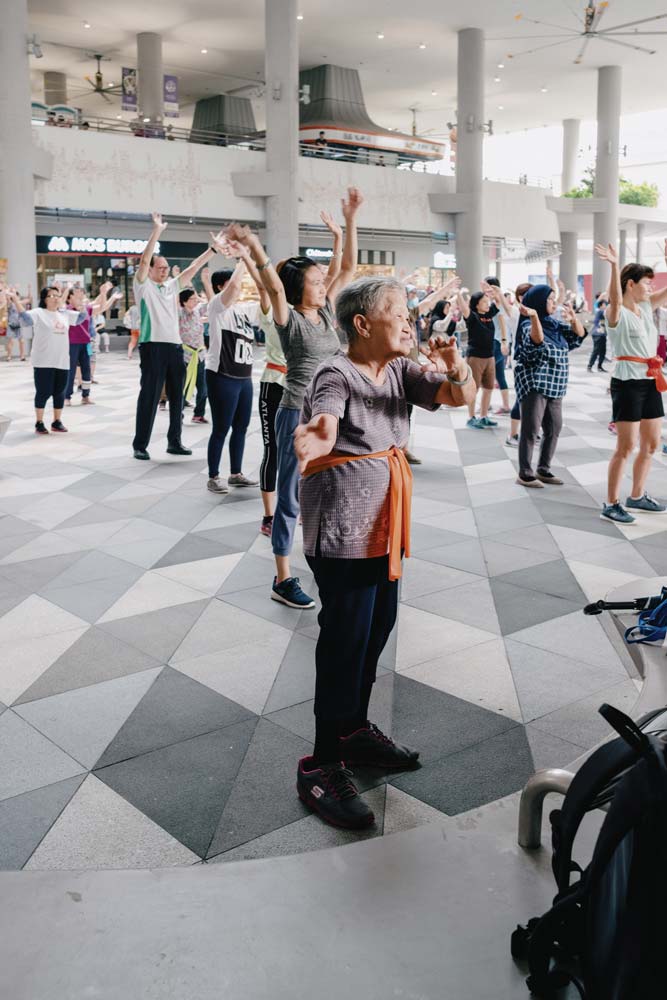
Perhaps nowhere is the government’s approach to planning more apparent than in the nation’s iconic public housing system. With the establishment in 1960 of the Housing and Development Board (HDB), Singapore embarked on a strategy to provide affordable housing for its growing population. Since its inception, HDB has built more than a million apartments in 24 towns and 3 estates spread across the island. A high rate of home ownership and mandatory mixed-income and mixed-race developments have kept housing for the most part safe, clean, and accessible.
The state offers flats with 99-year leaseholds, which buyers can finance with cash, bank loans, HDB loans, or with funds drawn from the Central Provident Fund, the state’s compulsory social security system. In many countries, public housing carries a stigma; in Singapore, where some 80 percent of the population lives in HDB buildings, it is the norm, and has provided a long-term answer to housing needs in this land- and resource-strapped city.
It makes sense then that the government would turn to HDB and the housing sector as one of the first areas for consideration in their age-friendly plan. According to the agency itself, the objectives have always been to make the city more livable, by “strengthening family ties,” and “taking care of the needs of the elderly and low-income families.”
In Singapore, where the cost of living runs sky high, many seniors worry about funding their retirement. And many of them tend to be cash-poor but asset-rich, their primary equity being their HDB flats. To answer this, the government unrolled a Lease Buyback Scheme, in which homeowners can sell part of their lease back to HDB. The funds then top off their Central Provident Fund retirement accounts, with the remainder being disbursed as cash.
In addition to this, other innovative ideas are underway to provide age-friendly housing solutions. The Proximity Housing Grant offers subsidies to buyers for purchasing a flat in close proximity to immediate family, either married couples or their parents looking to live closer to each other or singles looking to live near their aging parents. This helps ensure that families can continue to offer each other mutual support, particularly as the parents grow older. Three-generation (3Gen) flats, launched in 2013, are larger-than-average flats meant for three generations of a family who wish to reside under one roof. And starting in 2015, the two-room Flexi-Scheme allowed those 55-plus to downsize under more flexible lease conditions.
HDB has built more than a million apartments in 24 towns and 3 estates spread across the island. A high rate of home ownership and mandatory mixed-income and mixed-race developments have kept housing for the most part safe, clean, and accessible.
In the case of Kampung Admiralty, the concept of a multi-use building for older people is a natural extension of a long history of integrating commercial, recreational, and social amenities into HDB towns. But it is notable for its ambitious design tailored specifically for seniors, in which many of the government’s missions (active aging, healthy lifestyles, sustainable design, and community-centric towns) that had been percolating within individual agencies could be brought together under one roof. “All these ideas couldn’t have converged at a more opportune moment,” says Yap Chin Beng of the HDB.
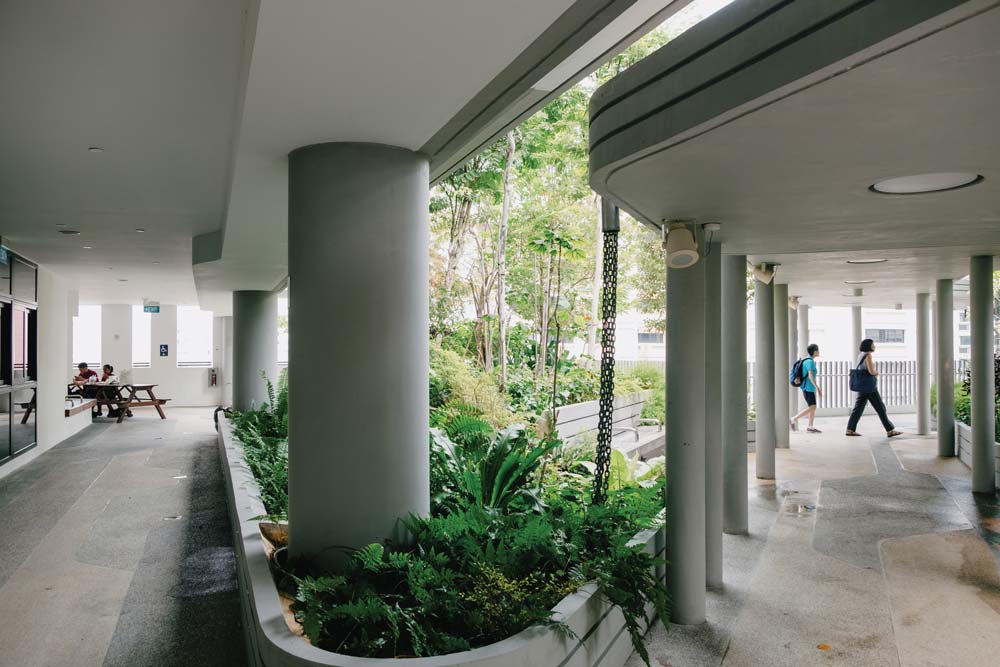
WOHA specifically designed the building to enforce visual and physical connections; no matter where they are in the building, residents have access to both nature and other people.
Kampung Admiralty is the first of 10 similar retirement communities to be built in Singapore, as HDB continues to evolve along with Singapore’s changing demographics. At his 2018 National Day address, delivered from Kampung Admiralty, Prime Minister Lee Hsien Loong (the son of Lee Kuan Yew) called the development “a model for future public housing,” one that “meets a need as our society ages.”
He went on to affirm the government’s commitment to a long-term strategy for age-friendly housing. “HDB will continue to develop other innovative housing concepts for the young as well as the old, so that future generations can also own their homes and live comfortably and happily in their neighborhoods.”
Creating Community
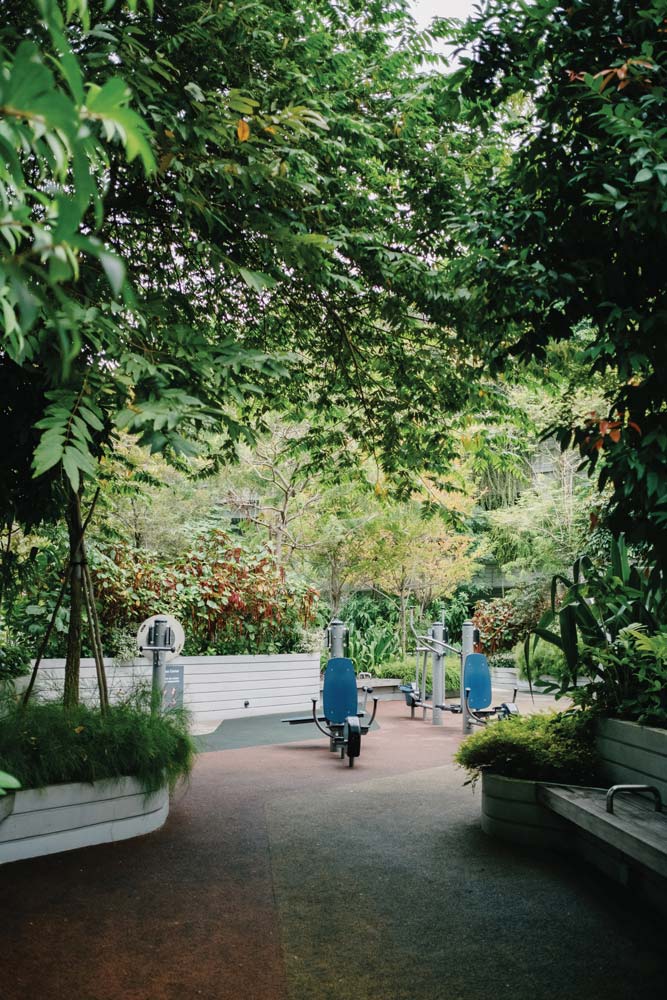
In the community kitchen of the Active Ageing Hub (AAH), a group of seven older women, including Asnah Daud, are busy chopping vegetables, frying noodles, and wrapping little mounds of sweetened tapioca into banana leaves. The women, some Chinese and others Malay, work together seamlessly in the galley style kitchen. Their laughter rises above the sounds of clattering dishes and sizzling oil.
The women volunteer every week to cook at the AAH, preparing food for other members who pay a small fee for homecooked meals that are often made with the produce from the building’s rooftop gardens. In the process, they have become friends, trading stories along with favorite recipes.
The AAH, which is run by eldercare and healthcare provider NTUC Health, is at the heart of the building’s thriving community. The AAH offers a comprehensive range of services, from senior day care and rehabilitation services, to community events and volunteering opportunities.
“This place has far exceeded our expectations,” says Jeannie Ho, a director at NTUC Health. The AAH has been at Kampung Admiralty since the building’s opening and since those early days, the center has been able to tailor its programming to meet the needs of the residents and community. Their weekly exercise classes, held four times a week in the massive community plaza on the ground level, have grown in popularity. Now, hundreds of people from within the building and the outside community move in unison to music pumped over the speakers, guided by upbeat instructors. The 10 a.m. class times were chosen after much trial and error to meet the schedules of senior attendees.
From the very beginning, the concept of community was written into the brief for the development, part of the government’s emphasis on longevity and quality of life, as opposed to elder care.
From the very beginning, the concept of community was written into the brief for the development, part of the government’s emphasis on longevity and quality of life, as opposed to elder care. Despite a strong central government administering world-renowned housing, health care, and education programs, the state has long fostered a culture of self-reliance — a pragmatic outlook on the role of social safety nets in a country with limited resources. The Many Helping Hands philosophy espoused by the government puts the onus of aging well onto individuals, with their families and communities as secondary sources of support.
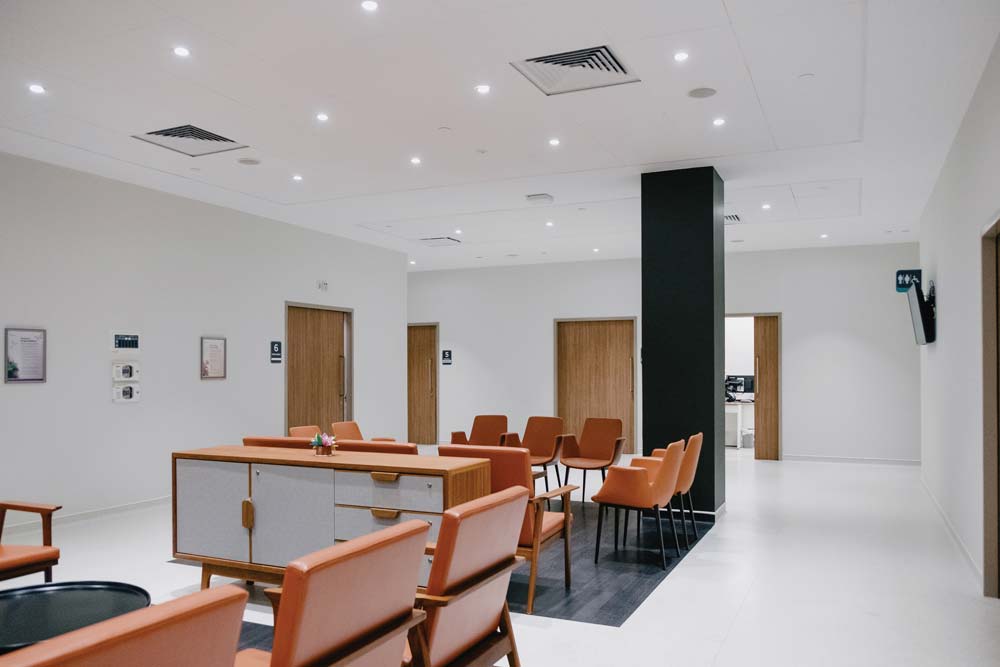
The on-site medical center was designed with thoughtful details to put seniors at ease — from the mid-century modern chairs in the waiting room that conjure up familiar memories of the 60s and 70s, to the massive windows in the recovery bays that give patients access to greenery and light.
Today, typical Asian family structures built on the Confucian virtue of filial piety, or respect for elders, are becoming less common, and adult children increasingly live apart from their parents. All of this makes a strong community even more essential. Places like Kampung Admiralty, with their built-in communities and support systems, will be invaluable in preventing isolation and loneliness in seniors and promoting independence.

“We’re not there yet,” says Ho. “But we’re working toward a more livable future.”
The village aspect of Kampung Admiralty has been strengthened by the ability of amenities and residential facilities to be housed within the same building. Seniors have the opportunity to apply for micro-jobs at the supermarket and hawker center, where they can work for short periods of time, interact with others, and earn extra income. Seniors with the AAH can volunteer to assist other residents in the building as activity and meal buddies, dementia friends, and even handymen. The building’s location directly next to an MRT station makes travel easy, both for residents who wish to go out and their friends and family who wish to visit.
Another example is the synergy between the AAH and the childcare center, whose close proximity has created a wealth of opportunities for cross-programming and intergenerational bonding. Seniors help care for the children during the week, taking them to the playground and participating in joint activities. This arrangement offers older volunteers a sense of purpose, belonging, and joy. Many residents also have grandchildren attending the childcare center, with whom they can spend time at the end of the day before the parents pick them up. This encourages multigenerational family bonding.
Daud and her husband Junit have quickly become part of this interdependent Kampung Admiralty community. In addition to Daud’s volunteer work at the AAH, Junit also regularly volunteers at the elder daycare center pushing wheelchairs for seniors with disabilities, many older than himself. Both of them find that staying busy and engaged post-retirement keeps their spirits up — and there’s never a shortage of things to do and people to talk to in their building. “We never feel down,” assures Junit. “If you can be around other people and stay active, then that means you’re young.”
Designing For Seniors
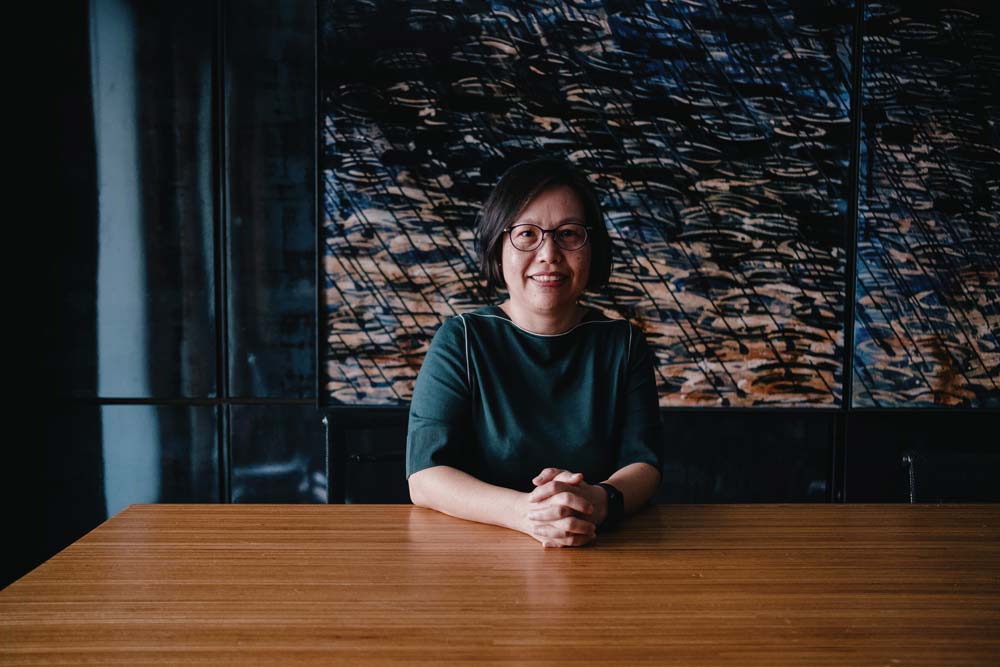
When walking the terraced rooftop gardens of Kampung Admiralty, one can almost forget the fact that the labyrinth of lush greenery is located on top of a building in the midst of one of the world’s most densely populated countries. Ho Soh Wah (no relation to Jeannie Ho), 70, a resident and avid garden club volunteer, points out some of the plants growing in meticulously planned and groomed raised garden beds: herbs like laksa and Thai basil, vegetables like Chinese spinach and okra, and trees bearing clusters of tiny bananas.
Though he initially had no gardening experience, he now spends several hours a day tending to what he affectionately calls his “babies,” many of which are harvested and eaten by members of the Active Ageing Hub. “My life was a routine production,” Mr. Ho says, referring to his days as an employee at a printing company. In his newly retired life, he reports that gardening has helped him to become more relaxed.
Architect and director Pearl Chee of WOHA was a team leader for the Kampung Admiralty project.
The gardens and green spaces are a key feature of the building’s design, and not just for decorative purposes. WOHA, the architecture firm responsible for the innovative design, envisioned the greenery as central to the idea of the modern kampung, encouraging people to get outside, meet and exercise in public spaces, and immerse themselves in nature — all integral to active aging and improved mental health.
Massive windows in the medical center overlook a central courtyard, offering patients the soothing sights and sounds of the outdoors. Vegetation and rain catchment structures also enhance the building’s efficiency, providing a natural landscape that recycles water for irrigation and cools the entire building.
From top to bottom, every aspect of Kampung Admiralty, from public areas to private residences, were thoughtfully designed to improve quality of life. Pearl Chee, a WOHA director, says the complexity of the design required “three-dimensional thinking.” In the past, all of the different silos (hospital, housing units, childcare center, shopping plaza) would have been produced separately; this new approach requires a more holistic mentality.
Its citizens — Singapore’s greatest resource — have always been at the center of these plans. As the world continues to urbanize and grow older at a rapid rate, the innovations coming out of Singapore will help guide other countries as they embrace their own demographic change.
As a nation of few resources and limited space, Singapore has always been forced to integrate design into every step of their nation building, from policies and services to infrastructure, in order to maximize outcomes. “Singapore is a nation by design,” said Prime Minister Lee Hsien Loong in 2018. “Nothing we have today is natural or happened by itself. Somebody thought about it, made it happen.” This robust design culture is the driving force behind the creation of Kampung Admiralty and determining how it could best serve older people, not only in terms of lofty policies, but right down to the brass tacks — or vinyl flooring, in this case.
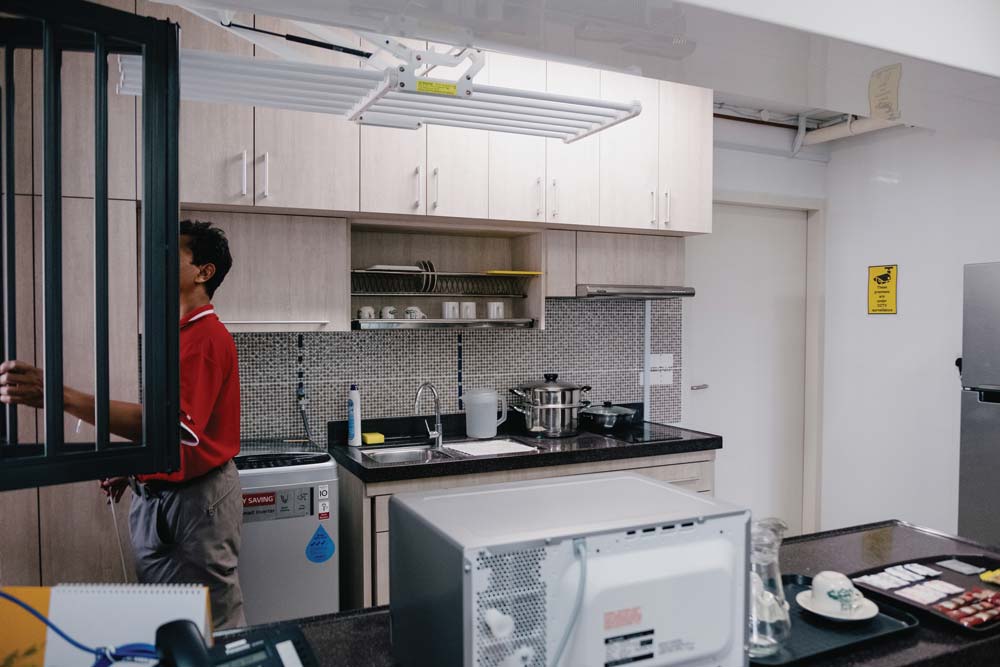
Apartments are designed for optimum daylight and natural cross ventilation. Each of the 104 units are outfitted with a variety of age-friendly amenities and fixtures including low countertops, induction cooktops, built-in retractable clotheslines, and slip- and moisture-resistant flooring.
The studio apartments, though small, incorporate many smart and thoughtful details that make life easier for seniors: flameless induction stoves, anti-slip flooring, retractable clotheslines, and easy-to-open monsoon windows. Rooms also come equipped with an emergency alert cord that can be pulled if help is required. Entrances are barrier-free and wide enough to accommodate wheelchairs, and all units are elevator accessible. WOHA even added “buddy benches” in the corridors to promote conversation and social interaction.
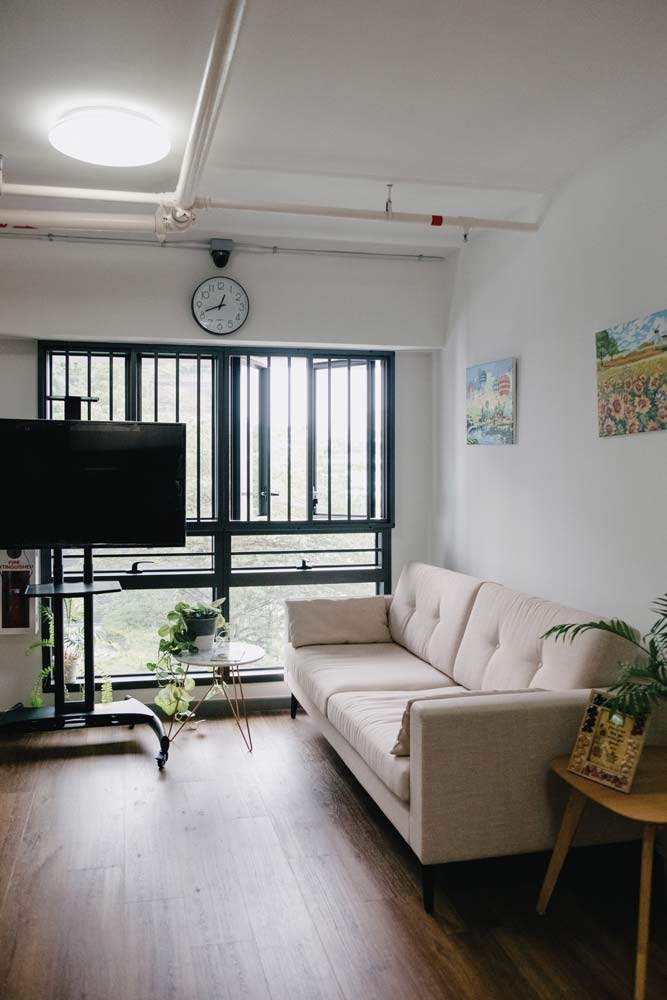
In the future, says Chee, she looks forward to replicating the same spirit of Kampung Admiralty in high rise form. Some of the other housing developments by WOHA have 50 or more stories. “Because of limited land, we're always building higher,” she explains. “I think the challenge is, how do you inject more public spaces into a high rise, and break it down to a more human scale?”
The end goal, of course, has always been to create a more livable environment, in Kampung Admiralty and the city as a whole. Its people — Singapore’s greatest resource — have always been at the center of these plans. As the world continues to urbanize and grow older at a rapid rate, the innovations coming out of Singapore will help guide other countries as they embrace their own demographic change.
The creation of Kampung Admiralty is the embodiment of a very Singaporean, collaborative approach to tackling society’s greatest challenges. Like the vibrant gardens that run throughout its tiered rooftops, Kampung Admiralty has become a diverse and thriving ecosystem unto itself — a self-contained building created by carefully cross-pollinating ideas and programs. Here, a well-designed infrastructure and well-tended social services ensure that residents can flourish throughout their later lives.
“This is the best place to grow old,” affirms Asnah Daud. She is sitting on a leather sofa next to Junit in their small, but cozy, apartment adorned with mementos of a full life — furnishings and pictures collected over the years, and artwork made during their time at Kampung Admiralty. Daud gestures around her to the place she now calls home, and then, out her windows to the soaring city of Singapore beyond. ●
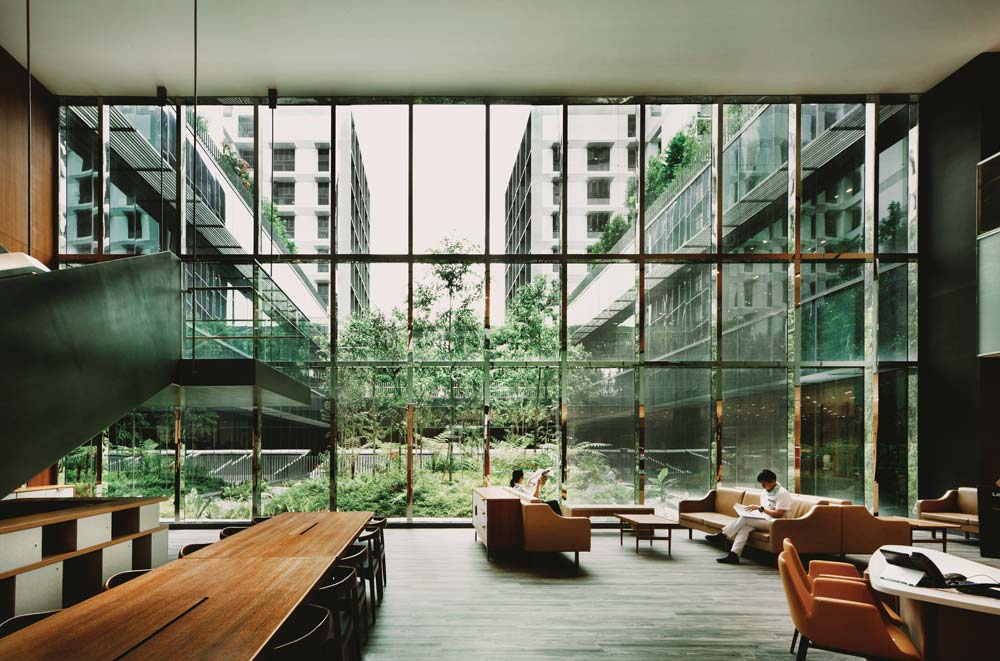
Interior photo by Patrick Bingham-Hall, Courtesy of WOHA
Photographs by Marco Javier